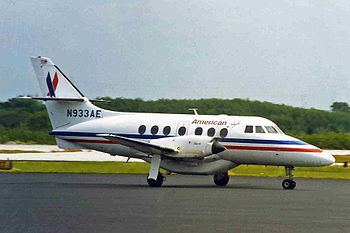Summary CFIT, Pilot Error Crew 2 Survivors 5 Number of deaths 15 Survivor 5 | Passengers 18 Fatalities 15 Date 13 December 1994 Passenger count 18 | |
 | ||
Similar Nigeria Airways Flight 9805, Iran Aseman Airlines Fl, 1994 Iranian Air Force C‑1, Air Algérie Flight 702P, AVAir Flight 3378 | ||
Flagship Airlines Flight 3379 was a scheduled American Eagle flight from Piedmont Triad International Airport to Raleigh-Durham Airport which crashed while executing a missed approach to the Raleigh-Durham airport the evening of Tuesday, December 13, 1994. The two pilots and 13 passengers died in the crash, five passengers survived.
Contents
The flight route from Greensboro to Raleigh is about 70 miles (110 km). Observers at the crash scene said it was foggy and sleeting. The airport reported a temperature of 37 °F (3 °C) with steady drizzle.
Accident
The crew for Flight 3379 were Captain Michael Hillis, 29, and First Officer Matthew Sailor, 25.
At 18:05, Flagship 3379 took off from Greensboro running late due to baggage loading. The aircraft climbed to a 9,000 feet (2,700 m) cruising altitude and contacted Raleigh approach control at 18:14, receiving an instruction to reduce the speed to 180 knots (330 km/h; 210 mph) and descend to 6,000 feet (1,800 m). Raleigh final radar control was contacted at 18:25 and instructions were received to reduce the speed to 170 knots (310 km/h; 200 mph) and to descend to 3,000 feet (910 m). At 18:30 the flight was advised to turn left and join the localizer course at or above 2,100 feet (640 m) for a runway 5L ILS approach.
Shortly after receiving clearance to land, the no. 1 engine ignition light illuminated in the cockpit as a result of a momentary negative torque condition when the propeller speed levers were advanced to 100% and the power levers were at flight idle. Captain Hillis suspected an engine flame out and eventually decided to execute a missed approach. The speed had decreased to 122 knots (226 km/h; 140 mph) and two momentary stall warnings sounded as the pilot called for max power. The aircraft was in a left turn at 1,800 feet (550 m) and the speed continued to decrease to 103 knots (191 km/h; 119 mph), followed by stall warnings. The rate of descent then increased rapidly to more than 1,000 feet per minute (300 m/min). The aircraft eventually struck some trees and crashed about 4 miles (6.4 km) southwest of the runway 5L threshold at 18:34.
The aircraft was manufactured in 1991 and had logged 6,577 flying hours.
Investigation
On October 24, 1995, the NTSB released their report on the crash. The crash was blamed on Captain Hillis assuming that an engine had failed. Hillis also failed to follow approved procedures for engine failure single-engine approach, go-around, and stall recovery. Flagship Airlines management were blamed for failing to identify, document, monitor and remedy deficiencies in pilot performance and training.
